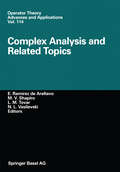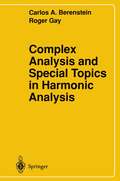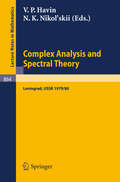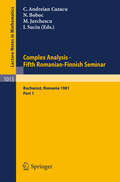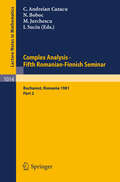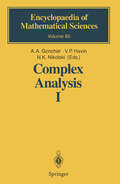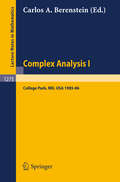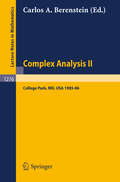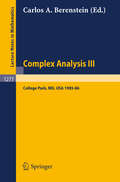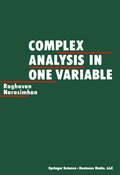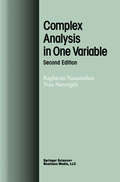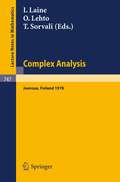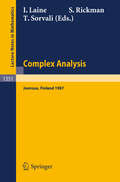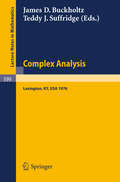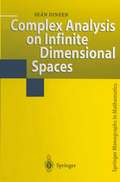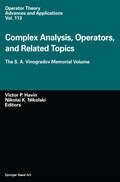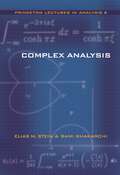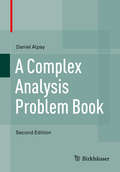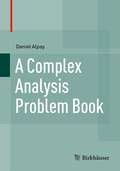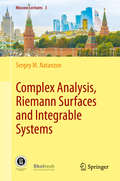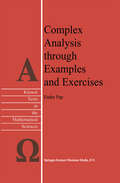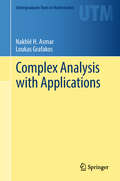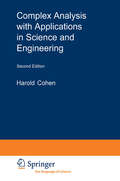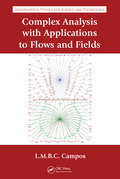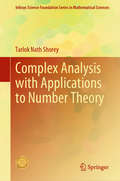- Table View
- List View
Complex Analysis and Related Topics (Operator Theory: Advances and Applications #114)
by E. Ramirez De Arellano M. V. Shapiro L. M. Tovar N. L. VasilevskiThis volume, addressed to researchers and postgraduate students, compiles up-to-date research and expository papers on different aspects of complex analysis, including relations to operator theory and hypercomplex analysis. Subjects include the Schrödinger equation, subelliptic operators, Lie algebras and superalgebras, among others.
Complex Analysis and Special Topics in Harmonic Analysis
by Carlos A. Berenstein Roger GayA companion volume to the text "Complex Variables: An Introduction" by the same authors, this book further develops the theory, continuing to emphasize the role that the Cauchy-Riemann equation plays in modern complex analysis. Topics considered include: Boundary values of holomorphic functions in the sense of distributions; interpolation problems and ideal theory in algebras of entire functions with growth conditions; exponential polynomials; the G transform and the unifying role it plays in complex analysis and transcendental number theory; summation methods; and the theorem of L. Schwarz concerning the solutions of a homogeneous convolution equation on the real line and its applications in harmonic function theory.
Complex Analysis and Spectral Theory: Seminar, Leningrad 1979/80 (Lecture Notes in Mathematics #864)
by V. P. Havin N. K. Nikol'SkiiComplex Analysis - Fifth Romanian-Finnish Seminar. Proceedings of the Seminar Held in Bucharest, June 28 - July 3, 1981: Part 1 (Lecture Notes in Mathematics #1013)
by C. Andreian Cazacu N. Boboc M. Jurchescu I. SuciuComplex Analysis - Fifth Romanian-Finnish Seminar. Proceedings of the Seminar Held in Bucharest, June 28 - July 3, 1981: Part 2 (Lecture Notes in Mathematics #1014)
by C. Andreian Cazacu N. Boboc M. Jurchescu I. SuciuComplex Analysis I: Entire and Meromorphic Functions Polyanalytic Functions and Their Generalizations (Encyclopaedia of Mathematical Sciences #85)
by M. B. Balk A. A. Gol'Dberg B. Ya. Levin I. V. OstrovskiiA two-part volume containing a comprehensive description of the theory of entire and meromorphic functions of one complex variable and its applications, and a detailed review of recent investigations concerning the function-theoretical pecularities of polyanalytic functions (boundary behaviour, value distributions, degeneration, uniqueness etc).
Complex Analysis I: Proceedings of the Special Year Held at the University of Maryland, College Park, 1985-86 (Lecture Notes in Mathematics #1275)
by Carlos A. BerensteinThe past several years have witnessed a striking number of important developments in Complex Analysis. One of the characteristics of these developments has been to bridge the gap existing between the theory of functions of one and of several complex variables. The Special Year in Complex Analysis at the University of Maryland, and these proceedings, were conceived as a forum where these new developments could be presented and where specialists in different areas of complex analysis could exchange ideas. These proceedings contain both surveys of different subjects covered during the year as well as many new results and insights. The manuscripts are accessible not only to specialists but to a broader audience. Among the subjects touched upon are Nevanlinna theory in one and several variables, interpolation problems in Cn, estimations and integral representations of the solutions of the Cauchy-Riemann equations, the complex Monge-Ampère equation, geometric problems in complex analysis in Cn, applications of complex analysis to harmonic analysis, partial differential equations.
Complex Analysis II: Proceedings of the Special Year Held at the University of Maryland, College Park, 1985-86 (Lecture Notes in Mathematics #1276)
by Carlos A. BerensteinComplex Analysis III: Proceedings of the Special Year Held at the University of Maryland, College Park, 1985-86 (Lecture Notes in Mathematics #1277)
by Carlos A. BerensteinComplex Analysis in one Variable
by NARASIMHANThis book is based on a first-year graduate course I gave three times at the University of Chicago. As it was addressed to graduate students who intended to specialize in mathematics, I tried to put the classical theory of functions of a complex variable in context, presenting proofs and points of view which relate the subject to other branches of mathematics. Complex analysis in one variable is ideally suited to this attempt. Of course, the branches of mathema tics one chooses, and the connections one makes, must depend on personal taste and knowledge. My own leaning towards several complex variables will be apparent, especially in the notes at the end of the different chapters. The first three chapters deal largely with classical material which is avai lable in the many books on the subject. I have tried to present this material as efficiently as I could, and, even here, to show the relationship with other branches of mathematics. Chapter 4 contains a proof of Picard's theorem; the method of proof I have chosen has far-reaching generalizations in several complex variables and in differential geometry. The next two chapters deal with the Runge approximation theorem and its many applications. The presentation here has been strongly influenced by work on several complex variables.
Complex Analysis in One Variable
by Raghavan Narasimhan Yves NievergeltThe original edition of this book has been out of print for some years. The appear ance of the present second edition owes much to the initiative of Yves Nievergelt at Eastern Washington University, and the support of Ann Kostant, Mathematics Editor at Birkhauser. Since the book was first published, several people have remarked on the absence of exercises and expressed the opinion that the book would have been more useful had exercises been included. In 1997, Yves Nievergelt informed me that, for a decade, he had regularly taught a course at Eastern Washington based on the book, and that he had systematically compiled exercises for his course. He kindly put his work at my disposal. Thus, the present edition appears in two parts. The first is essentially just a reprint of the original edition. I have corrected the misprints of which I have become aware (including those pointed out to me by others), and have made a small number of other minor changes.
Complex Analysis. Joensuu 1978: Proceedings of the Colloquium on Complex Analysis, Joensuu, Finland, August 24-27, 1978 (Lecture Notes in Mathematics #747)
by I. Laine O. Lehto T. SorvaliRomanian Finnish Seminar on Complex Analysis
Complex Analysis Joensuu 1987: Proceedings of the XIIIth Rolf Nevanlinna-Colloquium, Held in Joensuu, Finland, Aug. 10-13, 1987 (Lecture Notes in Mathematics #1351)
by Ilpo Laine Seppo Rickman Tuomas SorvaliThe articles in this volume are for the most part research articles related mainly to the theory of quasiconformal and quasiregular mappings, Riemann surfaces and potential theory. They have resulted from talks delivered at the 13th Nevanlinna Colloquium, which was also a celebration of the 80th birthday of Lars V. Ahlfors: hence many articles in this volume reflect his mathematical interests.
Complex Analysis. Kentucky 1976: Proceedings of the Conference Held at the University of Kentucky, May 18 - 22, 1976 (Lecture Notes in Mathematics #599)
by J. D. Buckholtz T. J. SuffridgeComplex Analysis on Infinite Dimensional Spaces (Springer Monographs in Mathematics)
by Sean DineenInfinite dimensional holomorphy is the study of holomorphic or analytic func tions over complex topological vector spaces. The terms in this description are easily stated and explained and allow the subject to project itself ini tially, and innocently, as a compact theory with well defined boundaries. However, a comprehensive study would include delving into, and interacting with, not only the obvious topics of topology, several complex variables theory and functional analysis but also, differential geometry, Jordan algebras, Lie groups, operator theory, logic, differential equations and fixed point theory. This diversity leads to a dynamic synthesis of ideas and to an appreciation of a remarkable feature of mathematics - its unity. Unity requires synthesis while synthesis leads to unity. It is necessary to stand back every so often, to take an overall look at one's subject and ask "How has it developed over the last ten, twenty, fifty years? Where is it going? What am I doing?" I was asking these questions during the spring of 1993 as I prepared a short course to be given at Universidade Federal do Rio de Janeiro during the following July. The abundance of suit able material made the selection of topics difficult. For some time I hesitated between two very different aspects of infinite dimensional holomorphy, the geometric-algebraic theory associated with bounded symmetric domains and Jordan triple systems and the topological theory which forms the subject of the present book.
Complex Analysis, Operators, and Related Topics: The S. A. Vinogradov Memorial Volume (Operator Theory: Advances and Applications #113)
by Victor P. Havin Nikolai K. NikolskiThis volume is devoted to some topical problems and various applications of operator theory and its interplay with modern complex analysis. 30 carefully selected surveys and research papers are united by the "operator theoretic ideology" and systematic use of modern function theoretical techniques.
Complex Analysis (PDF)
by Elias M. Stein Rami ShakarchiWith this second volume, we enter the intriguing world of complex analysis. From the first theorems on, the elegance and sweep of the results is evident. The starting point is the simple idea of extending a function initially given for real values of the argument to one that is defined when the argument is complex. From there, one proceeds to the main properties of holomorphic functions, whose proofs are generally short and quite illuminating: the Cauchy theorems, residues, analytic continuation, the argument principle. With this background, the reader is ready to learn a wealth of additional material connecting the subject with other areas of mathematics: the Fourier transform treated by contour integration, the zeta function and the prime number theorem, and an introduction to elliptic functions culminating in their application to combinatorics and number theory. Thoroughly developing a subject with many ramifications, while striking a careful balance between conceptual insights and the technical underpinnings of rigorous analysis, Complex Analysis will be welcomed by students of mathematics, physics, engineering and other sciences. The Princeton Lectures in Analysis represents a sustained effort to introduce the core areas of mathematical analysis while also illustrating the organic unity between them. Numerous examples and applications throughout its four planned volumes, of which Complex Analysis is the second, highlight the far-reaching consequences of certain ideas in analysis to other fields of mathematics and a variety of sciences. Stein and Shakarchi move from an introduction addressing Fourier series and integrals to in-depth considerations of complex analysis; measure and integration theory, and Hilbert spaces; and, finally, further topics such as functional analysis, distributions and elements of probability theory.
A Complex Analysis Problem Book
by Daniel AlpayThis second edition presents a collection of exercises on the theory of analytic functions, including completed and detailed solutions. It introduces students to various applications and aspects of the theory of analytic functions not always touched on in a first course, while also addressing topics of interest to electrical engineering students (e.g., the realization of rational functions and its connections to the theory of linear systems and state space representations of such systems). It provides examples of important Hilbert spaces of analytic functions (in particular the Hardy space and the Fock space), and also includes a section reviewing essential aspects of topology, functional analysis and Lebesgue integration.Benefits of the 2nd editionRational functions are now covered in a separate chapter. Further, the section on conformal mappings has been expanded.
A Complex Analysis Problem Book
by Daniel AlpayThis is a collection of exercises in the theory of analytic functions, with completed and detailed solutions. We wish to introduce the student to applications and aspects of the theory of analytic functions not always touched upon in a first course. Using appropriate exercises we wish to show to the students some aspects of what lies beyond a first course in complex variables. We also discuss topics of interest for electrical engineering students (for instance, the realization of rational functions and its connections to the theory of linear systems and state space representations of such systems). Examples of important Hilbert spaces of analytic functions (in particular the Hardy space and the Fock space) are given. The book also includes a part where relevant facts from topology, functional analysis and Lebesgue integration are reviewed.
Complex Analysis, Riemann Surfaces and Integrable Systems (Moscow Lectures #3)
by Sergey M. NatanzonThis book is devoted to classical and modern achievements in complex analysis. In order to benefit most from it, a first-year university background is sufficient; all other statements and proofs are provided. We begin with a brief but fairly complete course on the theory of holomorphic, meromorphic, and harmonic functions. We then present a uniformization theory, and discuss a representation of the moduli space of Riemann surfaces of a fixed topological type as a factor space of a contracted space by a discrete group. Next, we consider compact Riemann surfaces and prove the classical theorems of Riemann-Roch, Abel, Weierstrass, etc. We also construct theta functions that are very important for a range of applications. After that, we turn to modern applications of this theory. First, we build the (important for mathematics and mathematical physics) Kadomtsev-Petviashvili hierarchy and use validated results to arrive at important solutions to these differential equations. We subsequently use the theory of harmonic functions and the theory of differential hierarchies to explicitly construct a conformal mapping that translates an arbitrary contractible domain into a standard disk – a classical problem that has important applications in hydrodynamics, gas dynamics, etc. The book is based on numerous lecture courses given by the author at the Independent University of Moscow and at the Mathematics Department of the Higher School of Economics.
Complex Analysis through Examples and Exercises (Texts in the Mathematical Sciences #21)
by E. PapThe book Complex Analysis through Examples and Exercises has come out from the lectures and exercises that the author held mostly for mathematician and physists . The book is an attempt to present the rat her involved subject of complex analysis through an active approach by the reader. Thus this book is a complex combination of theory and examples. Complex analysis is involved in all branches of mathematics. It often happens that the complex analysis is the shortest path for solving a problem in real circum stances. We are using the (Cauchy) integral approach and the (Weierstrass) power se ries approach . In the theory of complex analysis, on the hand one has an interplay of several mathematical disciplines, while on the other various methods, tools, and approaches. In view of that, the exposition of new notions and methods in our book is taken step by step. A minimal amount of expository theory is included at the beinning of each section, the Preliminaries, with maximum effort placed on weil selected examples and exercises capturing the essence of the material. Actually, I have divided the problems into two classes called Examples and Exercises (some of them often also contain proofs of the statements from the Preliminaries). The examples contain complete solutions and serve as a model for solving similar problems given in the exercises. The readers are left to find the solution in the exercisesj the answers, and, occasionally, some hints, are still given.
Complex Analysis with Applications (Undergraduate Texts in Mathematics)
by Nakhlé H. Asmar Loukas GrafakosThis textbook is intended for a one semester course in complex analysis for upper level undergraduates in mathematics. Applications, primary motivations for this text, are presented hand-in-hand with theory enabling this text to serve well in courses for students in engineering or applied sciences. The overall aim in designing this text is to accommodate students of different mathematical backgrounds and to achieve a balance between presentations of rigorous mathematical proofs and applications. The text is adapted to enable maximum flexibility to instructors and to students who may also choose to progress through the material outside of coursework. Detailed examples may be covered in one course, giving the instructor the option to choose those that are best suited for discussion. Examples showcase a variety of problems with completely worked out solutions, assisting students in working through the exercises. The numerous exercises vary in difficulty from simple applications of formulas to more advanced project-type problems. Detailed hints accompany the more challenging problems. Multi-part exercises may be assigned to individual students, to groups as projects, or serve as further illustrations for the instructor. Widely used graphics clarify both concrete and abstract concepts, helping students visualize the proofs of many results. Freely accessible solutions to every-other-odd exercise are posted to the book’s Springer website. Additional solutions for instructors’ use may be obtained by contacting the authors directly.
Complex Analysis with Applications in Science and Engineering
by Harold CohenThe Second Edition of this acclaimed text helps you apply theory to real-world applications in mathematics, physics, and engineering. It easily guides you through complex analysis with its excellent coverage of topics such as series, residues, and the evaluation of integrals; multi-valued functions; conformal mapping; dispersion relations; and analytic continuation. Worked examples plus a large number of assigned problems help you understand how to apply complex concepts and build your own skills by putting them into practice. This edition features many new problems, revised sections, and an entirely new chapter on analytic continuation.
Complex Analysis with Applications to Flows and Fields
by Luis Manuel Braga da Costa CamposComplex Analysis with Applications to Flows and Fields presents the theory of functions of a complex variable, from the complex plane to the calculus of residues to power series to conformal mapping. The book explores numerous physical and engineering applications concerning potential flows, the gravity field, electro- and magnetostatics, steady he
Complex Analysis with Applications to Number Theory (Infosys Science Foundation Series)
by Tarlok Nath ShoreyThe book discusses major topics in complex analysis with applications to number theory. This book is intended as a text for graduate students of mathematics and undergraduate students of engineering, as well as to researchers in complex analysis and number theory. This theory is a prerequisite for the study of many areas of mathematics, including the theory of several finitely and infinitely many complex variables, hyperbolic geometry, two and three manifolds and number theory. In additional to solved examples and problems, the book covers most of the topics of current interest, such as Cauchy theorems, Picard’s theorems, Riemann–Zeta function, Dirichlet theorem, gamma function and harmonic functions.
